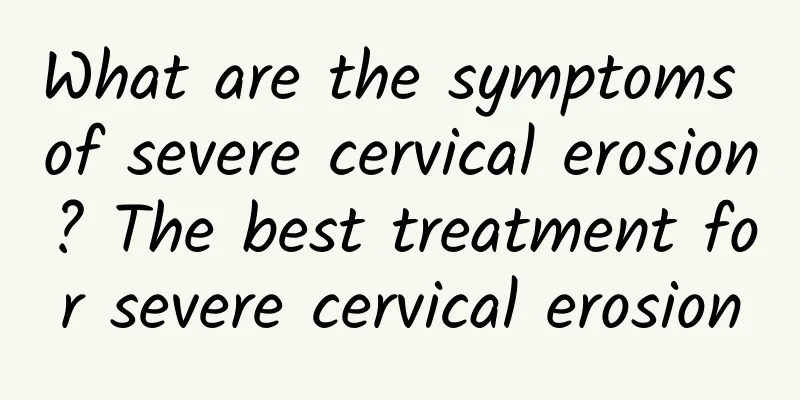What are the symptoms of severe cervical erosion? The best treatment for severe cervical erosion

|
Cervical erosion is a relatively common gynecological disease in women nowadays. Patients with cervical erosion do not show any symptoms when the disease first occurs, so many people will ignore this disease. However, when the disease develops to moderate and severe levels, it will be more troublesome to receive professional treatment. What are the symptoms of severe cervical erosion? Let’s take a look at them for you today. Cervical erosion is a common gynecological disease. The causes include mechanical stimulation or injury, such as sexual intercourse, miscarriage and delivery lacerations, and bacterial invasion causing cervicitis. When suffering from mild cervical erosion, patients generally have no obvious symptoms. There may also be only a slight increase in leucorrhea, which is often easily overlooked. Cervical erosion is discovered in many patients during general surveys or when they seek medical treatment for other gynecological diseases. The most obvious symptoms of patients with moderate and severe cervical erosion are increased leucorrhea, thick yellow discharge, or blood in the leucorrhea. A small number of patients may experience bleeding after sexual intercourse. Inflammatory leucorrhea can cause long-term irritation of the vulva and may also cause vulvar pruritus. In addition, since the cervical lymphatic system is directly connected to the paracervical connective tissue, inflammation can spread to the pelvic cavity through the lymphatic circulation, leading to pelvic connective tissue inflammation, and symptoms such as lumbar pain, lower abdominal distension, etc. Infertility in a small number of patients may also be caused by cervical erosion. Physical therapy is better for the treatment of moderate and severe cervical erosion, such as: laser, microwave, Bom light, red light, LEEP knife, etc. It is recommended that you go to the hospital and choose a treatment method that suits you under the guidance of a doctor. After the operation, sexual intercourse and tub baths are prohibited. Pay attention to hygiene, rest more, and strengthen nutrition. Tub baths, sexual intercourse and vaginal douching treatments are prohibited during the period when the wound has not healed (4-8 weeks). Regular follow-up after the operation. Patients with severe cervical erosion must pay attention to vaginal cleanliness and hygiene during the treatment process. They should refrain from sexual intercourse during this period, otherwise they will be easily harmed by bacteria and may be cross-infected. They should also pay attention to dietary adjustments and avoid eating irritating foods or foods that may cause congestion. |
<<: Are abortions harmful to women? Women must know the dangers of abortions
>>: Can I take medicine for a cold after an abortion? Taboos for women after an abortion
Recommend
What are the symptoms of bacterial vaginosis?
As the number of patients with bacterial vaginosi...
What is the cause of miscarriage at six months?
Six months refers to the sixth month of pregnancy...
Uterine fibroids are often associated with depression
Uterine fibroids are generally related to mental ...
What are the complications of irregular menstruation?
What are the complications of irregular menstruat...
What are the symptoms of pelvic inflammatory disease in the elderly?
Pelvic inflammatory disease is a very common gyne...
3 dietary treatments for recuperating after abortion
After an abortion, the patient's physical con...
Can I have an abortion at four months?
Abortion is possible at four months of pregnancy,...
Low-carb weight loss diet makes you slimmer, and these 4 major ingredients help you lose weight! Nutritionist: L-carnitine burns fat, catechins suppress appetite
Even if you want to lose weight, you still need t...
Constipation can also induce adnexitis in women
A short story: Xiao Li works as a salesperson in ...
Experts explain the causes of ovarian cysts
Ovarian cysts are a type of gynecological disease...
What are the diagnostic criteria for acute pelvic inflammatory disease?
What is acute pelvic inflammatory disease? What a...
Which female compatriots are prone to ectopic pregnancy
Nowadays, the incidence of ectopic pregnancy can ...
What are the dietary precautions for patients with threatened abortion?
What are the dietary precautions for patients wit...
What complications can cervicitis cause?
If cervicitis is not treated in time, it may lead...
Tips for women to prevent menopause
We must actively grasp the prevention methods of ...









